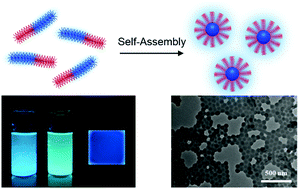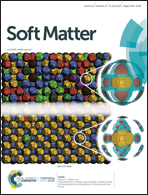Self-assembly of giant bottlebrush block copolymer surfactants from luminescent organic electronic materials†
Abstract
Bottlebrush copolymers have shown promise as building blocks for self-assembled nanomaterials due to their reduced chain entanglement relative to linear polymers and their ability to self-assemble with remarkably low critical micelle concentrations (CMCs). Concurrently, the preparation of bottlebrush polymers from organic electronic materials has recently been described, allowing multiple optoelectronic functions to be incorporated along the length of single bottlebrush strands. Here we describe the self-assembly of bottlebrush surfactants containing soluble n-butyl acrylate blocks and carbazole-based organic semiconductors, which self-assemble in selective solvent to give spherical micelles with CMCs below 54 nM. These narrowly dispersed structures were stable in solution at high dilution over periods of months, and could further be functionalized with fluorescent dyes to give micelles with quantum yields of 100%. These results demonstrate that bottlebrush-based nanostructures can be formed from organic semiconductor building blocks, opening the door to the preparation of fluorescent or redox-active micelles from giant polymeric surfactants.



 Please wait while we load your content...
Please wait while we load your content...